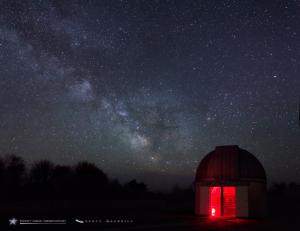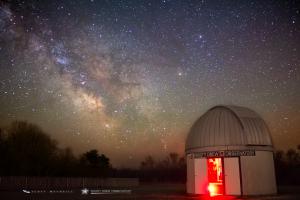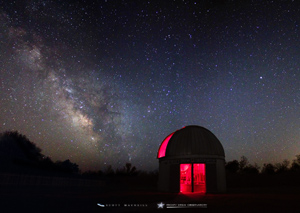
Public Stargazing
- Where:
- Frosty Drew Observatory
- When:
- Friday May 1, 2015 at 8:00 p.m.
- Cost:
- $1 Suggested Donation per Person
Happy May Day! Tonight's forecast is calling for partly cloudy to mostly clear skies intermittently. The super bright 94% waxing gibbous Moon will be with us all night long making for overly bright viewing conditions. Nights when the Moon is this bright make viewing of galaxies and nebulae near impossible and restrict our views to planets, stars, and of course the Moon. Tonight may not be the night to plan that geek out moment with the fabulous starscape at Frosty Drew, though if the Moon is your digs, then you will have 94% of it to freak out with.
We plan to open the Observatory and Sky Theatre at 8:00 p.m. tonight. In the Observatory, we will start with a twilight view of Venus, which has been brightly showing off its waning gibbous phase. Jupiter will be sky high at sunset and screaming for all to take a look with only three Galilean Moons visible until after 10:00 p.m. when Europa will swing around from behind. Additionally, the Great Red Spot should become quite visible around 9:00 p.m. The Moon will be on display periodically throughout the night and if the Moonlight doesn't chase us out early, Saturn will be on display after 11:30 p.m. In the Sky Theatre a slideshow of astrophotos shot at Frosty Drew will be on display or possibly a live projected view of the lunar surface. The bright Moon usually kicks us out early, though we could be around until near midnight if visitors keep coming. All together we will not close up until after 11:00 p.m. Check us out on Twitter (@FrostyDrewOBSY) or Facebook before heading out late, we always post a “Closing Up” tweet when we begin our break down operations.
Overall, tonight will not be the best night. Clouds and the bright 94% Moon will significantly restrict our viewing to only the brightest objects. The telescopes will be open and moments to geek out with our astronomers will available, so a night will be had. Just save the long, out of state drive for a darker night.
-------------------------------------------------------------------------
Weekly Happenings
Scott MacNeill

This past month, the NASA New Horizons mission, which is en route to Pluto, has passed another huge milestone in its nine year journey to the dwarf planet. Released on April 29th, the first images showcasing actual surface detail on Pluto were captured by the spacecraft. Though completely mind blowing, the images are going to keep getting better.
Launched in January 2006, New Horizons is the only mission to date with a primary mission of visiting Pluto. On July 14, 2015 the spacecraft will perform a fly-by maneuver of Pluto at a distance of 7,800 miles, that's about 3.4% the distance of the Moon from Earth. Though it will happen quickly, the number of high resolution images, atmospheric readings, magnetic field measurements, and surface evaluations collected by the mission will forever change our view of the distant world.
The new images showcasing surface details of Pluto hint at the possibility of a polar ice cap, which would be made of frozen molecular nitrogen. Additionally, the barycenter created by Pluto and its relatively large moon Charon is very visible. The barycenter is a gravitational center point or the center of mass that is created by the gravity of Pluto interacting with the gravity of Charon and functions as a center point that both objects orbit around. During the upcoming weeks and months, the images from New Horizons will keep getting better!
Check out the latest photo of Pluto and Charon. Then head over to the New Horizons mission page and get on board with one of the most anticipated missions happening in 2015. Woot!
Those who have been visiting Frosty Drew Observatory in the early morning hours over the past couple weeks of earlier moon set times have undoubtedly noticed the stunningly bright view of the Milky Way galaxy rising overhead from the Southeast. This view is usually the driver for early morning visitors this time of year and is really a mind blowing thing to see. Especially for all of us native to southern New England, where the Milky Way does not shine brightly in most places.
When looking to the summer view of the Milky Way, commonly referred to as the “Summer Milky Way”, we are actually seeing the bright Sagittarius Arm stretching towards the galactic central bulge, which sits among the constellations Sagittarius, Ophiuchus, and Scorpius. The Scutum-Centaurus Arm swings in from the right hand side of the galactic center and wraps around the central region, slightly obscuring our view. Under very dark skies, like those at Frosty Drew, the many dark nebulae that exist around the central bulge are visible. These dark nebulae are clouds of hydrogen gas and dust that is not interacting with any star light or stellar winds from our point of view and block the light of distant background stars.
The Milky Way is so bright at Frosty Drew Observatory because of the significant lack of light pollution in the skies overhead. Though light from neighboring communities continues to grow and every year we loose a little more of the breath taking view of the galaxy we live in. This is the view that has inspired generations of explorers to reach to the sky. Once it is gone, much of our wonder and curiosity of what is out there will fade with it. If you catch a chance at loosing yourself in the Milky Way this summer at Frosty Drew Observatory, remember that you can make a difference in bringing back and keeping the stunning view of the galaxy visible for all to be inspired by. Upgrade your outdoor lighting to dark-sky-friendly full cutoff fixtures, integrate a motion sensor, reduce the amount of light to only what is needed, or just turn off your lights and enjoy our natural habitat. The Earth is everybody's favorite place and we know of no place more beautiful. Stewarding our beautiful home should be a top priority!
-Scott


